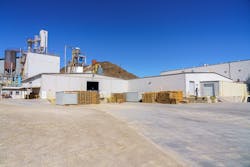Groundbreaking Work: Taking a Deeper Route to Decarbonizing Lithium Mining
No matter if you dig it or not, mining is crucial to the future energy transition.
The promised Net Zero Future would need mammoth amounts of lithium, nickel, iron and other elements to serve utility-scale and microgrid energy storage projects, as well as in the batteries of millions of electric vehicles.
The irony of moving from a coal mining past to a hyper-scale lithium and etc. mining future to decarbonize our grid and transportation is not lost on many of those who are either true believers and skeptics of the energy promises. The hard news is that it will take expensive, measured and eventually dramatic moves by the “clean” mining industry to truly practice what they preach.
The good news is that some firms are already headed that direction. Mining leaders such as ArcelorMittal, Rio Tinto, Solvay and BHP are contracting various carbon-reduction technologies, such as truck electrification and regenerative thermal oxidation, to achieve desired environmental improvements in their underground operations.
Another mining giant heading that direction is Albemarle Corp., the North Carolina-based chemicals manufacturer which owns the only lithium mine currently in operation in the U.S. Other companies are seeking regulatory approvals to open new mines, but Albemarle is already there. Albemarle is claimed as the first lithium producer to begin an independent third-party audit using the Initiative for Responsible Mining Assurance's standard for responsible mining at the company’s lithium brine extraction site, the Salar Plant, located in the Salar de Atacama.
The company is a United Nations Global Compact signatory, inclusive of the UNGC CEO Water Mandate, and announced intentions to achieve Net Zero emissions goals by 2050. Albemarle also promises to reduce the intensity of its freshwater usage by 25 percent by the end of this decade.
Overcoming a History of Dirty Hands, Neglect and Limitations
Toward those goals, the company has staged a series of “Insider” webinars focused on what it believes is necessary to reach a truly decarbonized supply chain for the future energy industry. Last week, Ellen Lenny-Pessagno, Albemarle Energy Storage global vice president for external affairs and sustainability, tackled the challenges in a forum with Aimee Boulanger, executive director of the advocacy and best-practices watchdog Initiative for Responsible Mining Assurance.
The focus was on admitting the environmental shortcomings of the industry while actively and openly seeking cleaner paths forward to make both ends of the energy transition truly net zero.
They didn’t pull punches.
“Now it’s an incredibly difficult table to sit at in its initial form because there is deeply broken trust between many communities where mining has happened,” Boulanger said. “And we have an industry which has the inherently difficult job to get at minerals which are locked in the earth. And the harm that has been left by many mining operations to date are the kind of impacts that can persist into the next ice age.”
Indeed, the history of the mining industry is one of truly dirty hands, by necessity, neglect and often limitations of technology at the time. But as Lenny-Pessagno of Albemarle noted, the end-all net results of lithium production is an integral part of the electrification and decarbonization supply chain.
“The critical message here is that for every kilo of greenhouse gas that we emit for our lithium extraction, you have 50 kilos avoided of greenhouse gas per year due to the operation of the electric vehicle,” she said.
Yes, she added, the mining industry is highly carbon- and greenhouse gas-intensive, but Albemarle and others are making present and future inroads to trim that negative impact. “We’re going to get where we need to be in the long term,” Lenny-Pessagno said during the webinar forum.
Minimizing the High Carbon Impact of a Decarbonizing Element
Vendor-neutral reports on the emissions profile of the lithium mining industry are stunning. EVs may be carbon neutral on the road, but lithium mining operations traditionally have emitted about 15 metric tons of carbon dioxide for every one ton of EV-grade lithium mined, according to a Climate Portal article by the Massachusetts Institute of Technology.
See our latest EnergyTech ENL with C&I Energy Transition insights on Pharma and Food companies
The mining energy efficiencies are getting better all the way, as companies such as BHP and Albemarle would attest. Even so, considering the International Energy Agency has estimated the world might need some 400,000 metric tons of lithium per year to truly serve the e-mobility goals of 2030, that would result in some six million metric tons of CO2 annually.
Hardly carbon neutral but still a pittance of the 1.1 billion metric tons of CO2 emitted by internal combustion machines every year in the U.S. alone, according to the federal Energy Information Administration.
Thus, the math of fleet and transportation electrification still makes tremendous environmental sense, even if the power grid and infrastructure are not quite there yet. One of the things which will aid the decarbonization of lithium mining is a strong focus on recycling, Albemarle’s Lenny-Pessagno pointed out.
“This does not take into account that lithium will be able to be recycled,” she said. “We don’t even know how many times, because the world is just gearing up to recycle lithium; that’s really the backdrop. Yes, we need to extract these critical minerals in order to reach these important goals to combat global warming, but it needs to be done in a very sustainable way and in concert with local communities.”
Best practices like independent audits of mining operations and emissions will certainly help.
“Ultimately, our key desire is not to just score and name or share or differentiate the ideas, but to understand the performance, understand where best practice would be and how can you make improvements on that path,” Boulanger said.
Tracking the chains of supply and custody will be aided by a set of rules and standards, she added.
“How is the material talked about from Point A to C to D so that by the time it reaches your care or it’s in a wind turbine or solar panel...is that if there are claims being made about the sourcing of that material, those claims can be backed up,” Boulanger noted.
Saluting the Salar and Future Goals to meet the Battery Supply Demand
Albemarle plans to invest about $50 million or so on work to double its U.S. lithium output to about 140,000 tons by 2025, according to earlier reports. The miner extracts lithium from salt water brine in Nevada and also at the Salar de Atacama complex in Chile, where the brine is pumped into evaporation ponds and then purified for future processing.
The company has been operating in the Salar for more than four decades, Lenny-Pessagno said. The lithium is brought out of the brine over a period of 18 months and is well into the path of cleaner operations from an emissions standpoint, in her opinion.
“And really when you’re there, it doesn’t feel like an industrial process,” the Albemarle executive said. “There really are no air emissions. . .. Our renewable energies transmission line is now hooked up (and) we’ll have renewable energy. Really, there is very little air quality impact.”
The promise of an e-mobility revolution, as well as incentives from federal legislation to tighten the battery supply chain, has resulted in many announcements around EV and utility-scale battery manufacturing and mining in the U.S. Automaker GM and Lithium Americas are collaborating on a proposed Thacker Pass mine in Nevada.
Ioneer, meanwhile, has secured a $700 million conditional loan commitment from the U.S. Department of Energy to create the Rhyolite Ridge Lithium-Boton mining and processing project in Esmeralda, Nevada. Ioneer is in the final stages of permitting processes for the Rhyolite Ridge project.
Most electric vehicles run on energy supplied by lithium-ion batteries. To reach Net Zero transportation goals, the IEA says, some two billion electric vehicles would need to be on the road by 2050.
Installed utility-scale stationary battery storage capacity could grow to 160 GWh in only a few years, according to the IEA. Many of those batteries will be composed of lithium-ion, lithium iron phosphate and also other technologies such as iron flow.
-- -- --
(Rod Walton, senior editor for EnergyTech, is a 15-year veteran of covering the energy industry both as a newspaper and trade journalist. He can be reached at [email protected]).
Follow us on Twitter @EnergyTechNews_ and @rodwaltonelp and on LinkedIn
About the Author
Rod Walton, EnergyTech Managing Editor
Managing Editor
For EnergyTech editorial inquiries, please contact Managing Editor Rod Walton at [email protected].
Rod Walton has spent 17 years covering the energy industry as a newspaper and trade journalist. He formerly was energy writer and business editor at the Tulsa World. Later, he spent six years covering the electricity power sector for Pennwell and Clarion Events. He joined Endeavor and EnergyTech in November 2021.
Walton earned his Bachelors degree in journalism from the University of Oklahoma. His career stops include the Moore American, Bartlesville Examiner-Enterprise, Wagoner Tribune and Tulsa World.
EnergyTech is focused on the mission critical and large-scale energy users and their sustainability and resiliency goals. These include the commercial and industrial sectors, as well as the military, universities, data centers and microgrids. The C&I sectors together account for close to 30 percent of greenhouse gas emissions in the U.S.
He was named Managing Editor for Microgrid Knowledge and EnergyTech starting July 1, 2023
Many large-scale energy users such as Fortune 500 companies, and mission-critical users such as military bases, universities, healthcare facilities, public safety and data centers, shifting their energy priorities to reach net-zero carbon goals within the coming decades. These include plans for renewable energy power purchase agreements, but also on-site resiliency projects such as microgrids, combined heat and power, rooftop solar, energy storage, digitalization and building efficiency upgrades.




